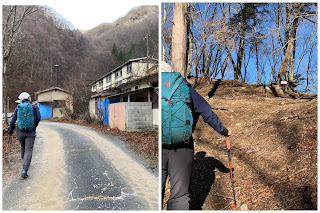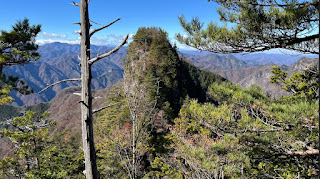Route name: Main ridge (Shu-ryo, 主稜)
Mountain: Mt Myoujin
(2931m明神岳)
Map sheet: 37 [Yama-to-kougen-chizu
(山と高原地図)
series]
Time: 1-2 days
Grade: Overall Grade 1 alpine route
The terrain around Kamikōchi (上高地) in
the North Alps is deservedly famous. With world-class natural beauty at every
turn, soaring ridgelines and peaks on all sides, and the famous view of the
Hotaka range from the Kappabashi bridge, people flock here with their cameras
throughout the high season.
For the alpine climber there is no shortage of classic variation
routes to play on, and they don’t come much more classic than the main ridge of
Mt Myoujin. Viewed from Kappabashi the ridge looks improbably steep and
inaccessible, but on closer inspection turns out to be quite reasonable.
Similar in size and technicality to something like the Genjiro ridge on Mt Tsurugi,
it provides a fantastic gateway to the Hotaka range, but without any of the
crowds and the chains and ladders that festoon the main trails.
Like its neighbour, the north ridge of Maeho, this route calls
out to the alpine climber. For those looking for speed, it can be done
lightweight in a single (long) day up and down, but the full experience demands
a bivvy on or near the airy summit of Mt Myoujin. Spectacular!
Getting there:
The start point of this itinerary is Kamikōchi (上高地) in
the North Alps (北アルプス).
If travelling by train from Tokyo (東京)
or Shinjuku (新宿),
take a Super Azusa limited express train on the Chuō Line (中央線) out
to Matsumoto (松本)
station. From there you need to change
to the Alpico Line for a 30-minute train ride to Shinshimashima (新島々).
The final leg of the journey is a bus ride of about an hour from outside the
train station at Shinshimashima to the alpine village of Kamikōchi, nestled at
the foot of the Hotaka range in the North Alps.
If travelling by car, you need to get to one of the car
parks at Sawando (さわんど)
on route 158, as private vehicles are prohibited from entering the Kamikōchi
area. From Sawando, take a bus or taxi to Kamikōchi. Buses are regular and cost
around ¥1000,
and a taxi (quicker and more convenient) will set you back about ¥6000.
Description:
If you’re planning to camp up on the summit ridgeline, make
sure you load up with plenty of water for the whole trip. There are no water
sources on this route once you leave the Kamikōchi vicinity.
From the Kamikōchi bus terminal, walk about 5 minutes to
reach Kappabashi, and cross the bridge. Continue for around 15 minutes through beautiful
low-lying marshland along the river until you reach the trailhead for the
Dakesawa (岳沢) valley.
The hiking trail between here and the Dakesawa hut is
punctuated every so often with a numbered sign, descending from 10 to 1. Hike
up the trail for around half an hour until you reach the number 7 signboard. From
here a thin trail heads off up the slope on the right, and this is the approach
to the Myoujin Shu-ryo.
You will be hiking/scrambling up this trail for the next 3
hours or so, and it is consistently steep, but fairly clear with no particular
route-finding difficulties. As you progress up through the various zones
(forest, sasa, haimatsu) the trail begins to open out and you’ll eventually
exit tree line. At one point you’ll need to scramble up a very exposed section
of rock ridge, and there are occasional ring bolts if you feel the need for the
security of a rope.
Eventually you will emerge onto a sort of plateau, with
multiple flat tent spots dotted around it. From here a steep trail will bring
you to the summit of peak 2726, also known as Myoujin V. This is the first peak
along the Shu-ryo itself, and there is a vintage wood-shafted ice axe marking
the summit.
Now you are on the ridge proper, and the next 3-4 hours will
be spent traversing the peaks of the Myoujin massif from V down to I, the main
summit.
A steep descent from Myoujin V brings you to the V/IV col. Continue
up the ridge along a fairly clear trail to gain Myoujin IV.
From here you will now see the real meat of the traverse
ahead. A short traverse brings you to the foot of the rocky fortress of Myoujin
III. This peak is basically tackled head-on, with a steep and exposed section
of scrambling.
Scramble down the other side, and then hike along the ridge
to Myoujin II. Scramble up to the top, and continue until you reach the far
end, and you’ll find an in-situ rappel anchor. From here you can descend in two
vertical 25m rappels, with a good intermediary anchor halfway down.
Now you just need to scramble up the slope ahead to reach
the main summit of Myoujin I (2931m). There is a single tent platform right at
the summit, but if this is taken, climb down the other side a short way and
there are several more spots where a tent can be pitched. This whole area is airy
and exposed, with dramatic views on all sides.
From Myoujin you now need to continue on to the 3090m summit
of Maehotaka. First walk down the airy ridgeline from Myoujin, and scramble up
a small intermediary summit. On the far side of this lies a very steep and
exposed downclimb of around 40m in length. The exposure is tremendous, and most
people describe this downclimb as the psychological crux of the route.
Once down, continue scrambling up the ridgeline with some relatively
complex route-finding to cover the 200m of elevation to the broad flat rocky summit
of Maeho. For many people this will be the highpoint of the route and the views
all around, and particularly down the north ridge of Maeho, are truly exhilarating.
Getting down:
From the summit of Maeho you need to drop steeply down the
main trail for around 20 minutes, with chains in places, to reach the trail
junction at Kimiko-daira (紀美子平).
From here you have the option to do an out-and-back along the Tsuri-one (吊尾根) ridgeline
to reach the 3190m summit of Mt Okuhotaka (奥穂高岳), the high point of the North Alps.
Once back at Kimiko-daira, continue down the Dakesawa trail for
around two hours to reach the Dakesawa hut. This trail is infamous… one of the
steepest trails in Japan, and an absolute knee-crusher. Hang in there, keep
repeating “this too shall pass”, and you’ll get down it.
From the Dakesawa hut there just remains about 1h50m of map
time down the hiking trail back to the trail junction and on to Kamikōchi.
Overall:
A stunning variation route, of moderate technical difficulty
for those with the requisite climbing experience, without the crowds of the nearby
ridgelines and trails. Mandatory rappels from Myoujin II require a 50m rope, and
a night up on the summit makes for a very memorable outing.
*** Don't forget that you can support the work it takes me to add to and maintain this site by buying your copies of the Climb Japan guidebooks on Amazon. Thanks so much! ***




























































